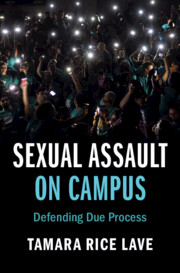51 results
3 - Son of a Bitch
-
- Book:
- Bitch
- Print publication:
- 27 June 2024, pp 69-97
-
- Chapter
- Export citation
16 - Sexual Violence in History
-
-
- Book:
- The Cambridge World History of Sexualities
- Published online:
- 26 April 2024
- Print publication:
- 16 May 2024, pp 339-361
-
- Chapter
- Export citation
5 - Victim Decision-Making
- from Part II - Pretrial Phase Decision-Making
-
-
- Book:
- The Cambridge Handbook of Psychology and Legal Decision-Making
- Published online:
- 22 February 2024
- Print publication:
- 29 February 2024, pp 69-85
-
- Chapter
- Export citation
5 - Intersectional Advocates and Organizations
-
- Book:
- Intersectional Advocacy
- Published online:
- 05 January 2024
- Print publication:
- 04 January 2024, pp 134-178
-
- Chapter
- Export citation
Chapter 10 - LGBTQIA+ Care
-
-
- Book:
- Urban Emergency Medicine
- Published online:
- 20 July 2023
- Print publication:
- 03 August 2023, pp 123-132
-
- Chapter
- Export citation
4 - A Godly Touch of Male Power: Phrenology, Mesmerism and Gendered Authority
-
- Book:
- Science and Power in the Nineteenth-Century Tasman World
- Published online:
- 18 May 2023
- Print publication:
- 01 June 2023, pp 107-125
-
- Chapter
- Export citation
Courting Victims: Exploring the Legal Framing of Exploitation in Human Trafficking Cases
-
- Journal:
- Canadian Journal of Law & Society / La Revue Canadienne Droit et Société / Volume 37 / Issue 3 / December 2022
- Published online by Cambridge University Press:
- 16 January 2023, pp. 409-429
-
- Article
-
- You have access
- Open access
- HTML
- Export citation
11 - Prosecutors Turning Arrests into Convictions
- from Part III - The Mechanics of Mass Incarceration
-
- Book:
- Mass Incarceration Nation
- Published online:
- 03 November 2022
- Print publication:
- 17 November 2022, pp 108-120
-
- Chapter
- Export citation
Socio-demographic and clinical characteristics of the perpetrators of sexual assaults assessed at the psychiatric department of Mahdia
-
- Journal:
- European Psychiatry / Volume 65 / Issue S1 / June 2022
- Published online by Cambridge University Press:
- 01 September 2022, p. S606
-
- Article
-
- You have access
- Open access
- Export citation
5 - The Forensics of Sexual Crimes against Children
-
- Book:
- The Science of Proof
- Published online:
- 25 August 2022
- Print publication:
- 01 September 2022, pp 142-170
-
- Chapter
- Export citation
Sexual Assault in the Mahdia Region: Medico Legal Aspects
-
- Journal:
- European Psychiatry / Volume 65 / Issue S1 / June 2022
- Published online by Cambridge University Press:
- 01 September 2022, p. S281
-
- Article
-
- You have access
- Open access
- Export citation
State Responsibility for International Bail Jumping
-
- Journal:
- Canadian Yearbook of International Law / Annuaire canadien de droit international / Volume 59 / November 2022
- Published online by Cambridge University Press:
- 22 July 2022, pp. 104-132
- Print publication:
- November 2022
-
- Article
-
- You have access
- Open access
- HTML
- Export citation

Sexual Assault on Campus
- Defending Due Process
-
- Published online:
- 23 June 2022
- Print publication:
- 07 July 2022
Assessing the factorial validity and the internal reliability of the International Trauma Questionnaire (ITQ); PTSD and complex PTSD among survivors of sexual violence in Ireland
-
- Journal:
- Epidemiology and Psychiatric Sciences / Volume 31 / 2022
- Published online by Cambridge University Press:
- 17 June 2022, e42
-
- Article
-
- You have access
- Open access
- HTML
- Export citation
Chapter 18 - De-forming and Re-making
- from Part V - Envisioning Race
-
-
- Book:
- Race in American Literature and Culture
- Published online:
- 26 May 2022
- Print publication:
- 16 June 2022, pp 292-306
-
- Chapter
- Export citation
Hallucinations as a risk marker for suicidal behaviour in individuals with a history of sexual assault: a general population study with instant replication
-
- Journal:
- Psychological Medicine / Volume 53 / Issue 10 / July 2023
- Published online by Cambridge University Press:
- 14 June 2022, pp. 4627-4633
-
- Article
-
- You have access
- Open access
- HTML
- Export citation
Sexual assault in the mahdia region : Epidemiological peculiarities of victims
-
- Journal:
- European Psychiatry / Volume 64 / Issue S1 / April 2021
- Published online by Cambridge University Press:
- 13 August 2021, p. S548
-
- Article
-
- You have access
- Open access
- Export citation
Evaluating #MeToo: The Perspective of Criminal Law Theory
-
- Journal:
- German Law Journal / Volume 22 / Issue 5 / August 2021
- Published online by Cambridge University Press:
- 06 August 2021, pp. 833-846
-
- Article
-
- You have access
- Open access
- HTML
- Export citation
6 - Harassment and the Virtual Workplace
-
- Book:
- The Virtual Workplace
- Published online:
- 08 June 2021
- Print publication:
- 17 June 2021, pp 163-184
-
- Chapter
- Export citation
Ignoring Implementation: Defects in Canada’s “Rape Shield” Policy Cycle
-
- Journal:
- Canadian Journal of Law & Society / La Revue Canadienne Droit et Société / Volume 36 / Issue 1 / April 2021
- Published online by Cambridge University Press:
- 30 April 2021, pp. 23-46
-
- Article
-
- You have access
- HTML
- Export citation



